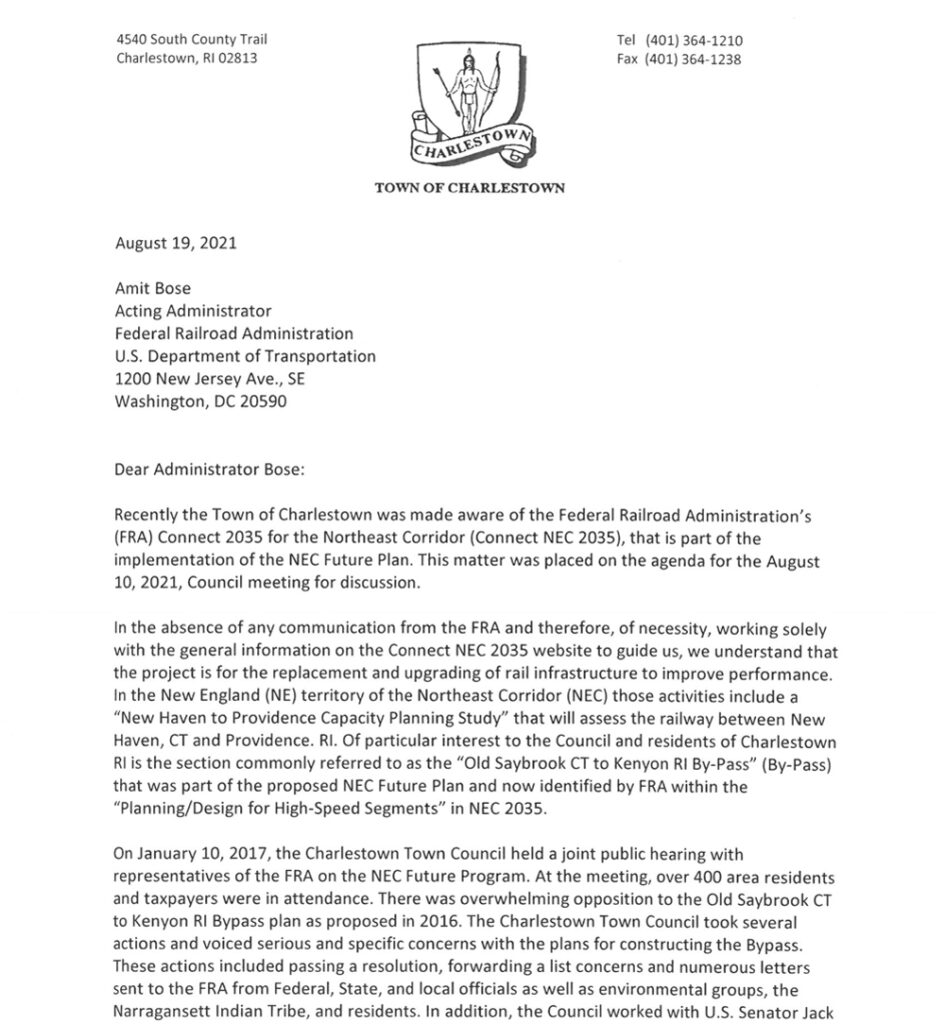Bonnie Van Slyke: Town Council Sends Letter To Federal Railroad Administration
The following letter was sent to local newspapers and is shared with us here by the author Bonnie Van Slyke. Bonnie Van Slyke is a member of the Charlestown Town Council.
At its August 10 meeting, the Charlestown Town Council discussed the new plan just announced by the Federal Railroad Administration (FRA) through which it will implement its long-term vision for rail service between Washington, DC, and Boston, MA. The new plan is called Connect NEC 2035, and it contains a map of the area between New Haven and Providence that contains Charlestown and that is to be the subject of a study of rail capacity—a study called the New Haven to Providence Capacity Study.
At the Council meeting, I proposed a motion “to authorize Town Administrator Mark Stankiewicz to take whatever action is necessary to protect the town” from changes to rail alignments or other proposals that may be made as part of the New Haven to Providence Capacity Planning Study. The authorization is needed so that the Town can be nimble as circumstances unfold.
Designated in the plan is “planning/design for high-speed segments” in our area; in short, it appears the study is intended to come up with a solution to the issues that led to the FRA proposing the “Old Saybrook to Kenyon Bypass” in the first place not so very long ago. Therefore, it is possible that the original plans could be revived.
The “Old Saybrook to Kenyon Bypass” was a plan by the FRA to bisect Charlestown with new high-speed tracks that would have run from Charlestown’s western edge to its eastern edge—through the Burlingame State Wildlife Management Area; through other state and private open space and homes in Burdickville village; across farms, including a four-generation farm-to-table operation on top of Schumankanuc Hill; over Native American tribal land; through the center of the 1,112-acre Carter Preserve (owned by The Nature Conservancy); through the middle of the Revolutionary-era Amos Green Farm and adjacent properties protected by conservation easements; through federally funded Historic Columbia Heights housing; and then over Historic Kenyon— to reconnect with the existing railroad near the eastern edge of town in the Great Swamp State Wildlife Management Area. In addition, the Bypass would have crossed the National Wild and Scenic Pawcatuck River several times and was entirely within the areas of the US Fish and Wildlife Great Thicket National Wildlife Refuge and the Wood-Pawcatuck Sole Source Aquifer.
Charlestown was very happy when the FRA released its Record of Decision on July 12, 2017, and the “Old Saybrook to Kenyon Bypass” was omitted (a huge accomplishment). The Record of Decision did, however, require a study of capacity issues in our area. Now four years later, the New Haven to Providence Capacity Planning Study is that study, which leaves open the door for rail alignments and perhaps the Bypass.
Following the unanimous vote of the Town Council to authorize the Town Administrator to take whatever steps needed to protect the town, as a first step a letter to the FRA, below, was drafted and signed by the Town Council. The letter poses key questions to the FRA and asks for clarification before the Town takes any official action. Copies of the letter were also sent to our legislators and to organizations that supported or partnered with Charlestown to defeat the Old Saybrook to Kenyon Bypass in 2017.



You can learn more about Bonnie at her profile page.
Visit The Railroad Page To Learn More About Past Work To Stop The Bypass
August 30, 2021 @ 5:27 am
I am pleased to see that the town is continuing to pursue answers to basic questions about the FRA’s intentions regarding the planning of high-speed rail traffic within Charlestown. So far, all we have heard is assurances from Mr. Flynn of Amtrak that really carries no weight in FRA’s decision making process.